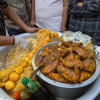It is a time of spiritual reflection, self-discipline, and fasting from dawn to dusk. However, despite abstaining from consuming food for long hours, many individuals struggle with weight management due to hidden calories in their meals. While breaking the fast with nutritious food is essential, being mindful of calorie-dense items can help maintain a balanced diet throughout the month.
Many common foods consumed during sehri and iftar may seem light but can significantly contribute to daily calorie intake. Understanding these hidden sources of calories can help make smarter dietary choices for a healthier Ramadan and beyond.
Frequently, we receive patients in our chambers with heaps of frustrations that they are starving and depriving their bodies and souls, suffocating the desire for food, but still failing to make any substantial positive results in terms of weight reduction. This is especially true during Ramadan when many struggle with weight gain instead of weight loss, despite fasting for hours.
Whenever one is under a diet plan, whether to reduce weight or due to any other clinical issues, it's very important to ascertain foods of fewer and higher calories. In our country, there are some highly consumed common foods which are taken usually just as a snack, but contain a good amount of calories. During Ramadan, these foods are often part of iftar or sehri, unknowingly adding extra calories.
Puffed rice (muri), toast biscuits, dates, nuts, banana, suji, flattened rice flakes (chira), and any deep-fried items are just some on this list of calorie-heavy foods. While dates are an essential part of breaking the fast due to their nutritional benefits, consuming them in excess can lead to high sugar intake.
Banana is the most widely consumed fruit in our country which contains a large amount of calories and carbohydrates. For patients who are on weight-reducing diets or are diabetic, it must not be considered as a fruit but rather a portion of carb. Including bananas in iftar should be done in moderation to avoid excessive calorie intake.
Fruit juices are preferred over whole fruits, especially by children. Because of the lack of fibre, fruit juices carry more calories than the fruits. Many people break their fast with fruit juices, believing them to be a healthy alternative, but these can spike blood sugar levels due to their high sugar content.
High-fibre fruits and vegetables help us reduce daily calorie intake. It also improves the satiety level and reduces hunger pangs. Dried fruits like dates, raisins, prunes, and dried mango bars (aamshotto) are rich sources of calories, although these are just random finger food for many families. Opting for whole fruits over dried fruits can help in managing calorie intake during Ramadan.
Anyone who wants to get rid of hidden calories must be aware of high glycaemic index fruits and vegetables. Mangoes, litchis, jackfruits, grapes, pomegranate, potatoes, carrots, yams, and sweet pumpkins, (all root and tuber vegetables) contain a high glycaemic index.
Olive oil has enormous health benefits, like reducing bad cholesterol, boosting the immune system etc. but also containing high calories. One teaspoon carries about 45kcal. So, having too much olive oil to reap its health benefits would backfire on any weight reduction initiatives. Using minimal oil for Iftar preparations can prevent unnecessary calorie consumption.
Measurement and restriction in oil should get the highest priority in a low-calorie meal plan. The most common mistake that people make is to reduce carb, protein and other categories of food, without keeping count of their daily oil intake through cooking. During Ramadan, deep-fried foods such as pakoras and samosas are widely consumed, making it crucial to find healthier alternatives like baked or grilled options.
Oil is the most calorie-dense ingredient in the food world. Another calorie-dense food item is table sugar. A slight difference in the amount of sugar in a recipe can make a considerable change in the amount of total calories. Limiting sugar in traditional drinks such as sherbets can help control calorie intake.
While nuts are a great energy booster during fasting, portion control is essential to prevent excessive calorie consumption.
Serving wise, puffed rice (muri) and rice flakes (chira) contain all the nutrients of rice and the same amount of calories except the moisture. Two cups of rice are equal to four cups of puffed rice (muri). But puffed rice does not provide hunger-satiety like rice. Many people consume large amounts of muri during iftar, assuming it is a light snack, but its calorie content should be considered carefully.
The same applies to toast biscuits and bread. Two to three slices of bread could be the carbohydrate part of a main meal whereas toast biscuits, which contain the same ingredients and calories are most of the time eaten in good numbers as a snack. Choosing whole-grain bread over processed toast biscuits can be a healthier alternative.
Dairy cream and thick mayo, butter, ghee and sauces add extensive calories to an otherwise healthy meal. These are often high in sugar or high-fructose corn syrup. During Ramadan, creamy sauces and heavy gravies should be replaced with healthier options like yogurt-based dips or homemade spice blends.
Pick the options lower in calories and sugar such as mustard, vinegar, lime juice, hot sauce, garlic, herbs, and spices are almost calorie-free, contain antioxidants and offer lots of flavours. It would also be helpful to cut the extra calories from a meal and make the meal much healthier.
Ramadan is a time for balance — not just spiritually, but also in our eating habits. By being mindful of hidden calories in our Sehri and Iftar meals, we can maintain a healthy weight while still nourishing our bodies for the long fasting hours. Smart choices, portion control, and healthier alternatives can ensure that fasting is beneficial both for the soul and for overall well-being.







Comments